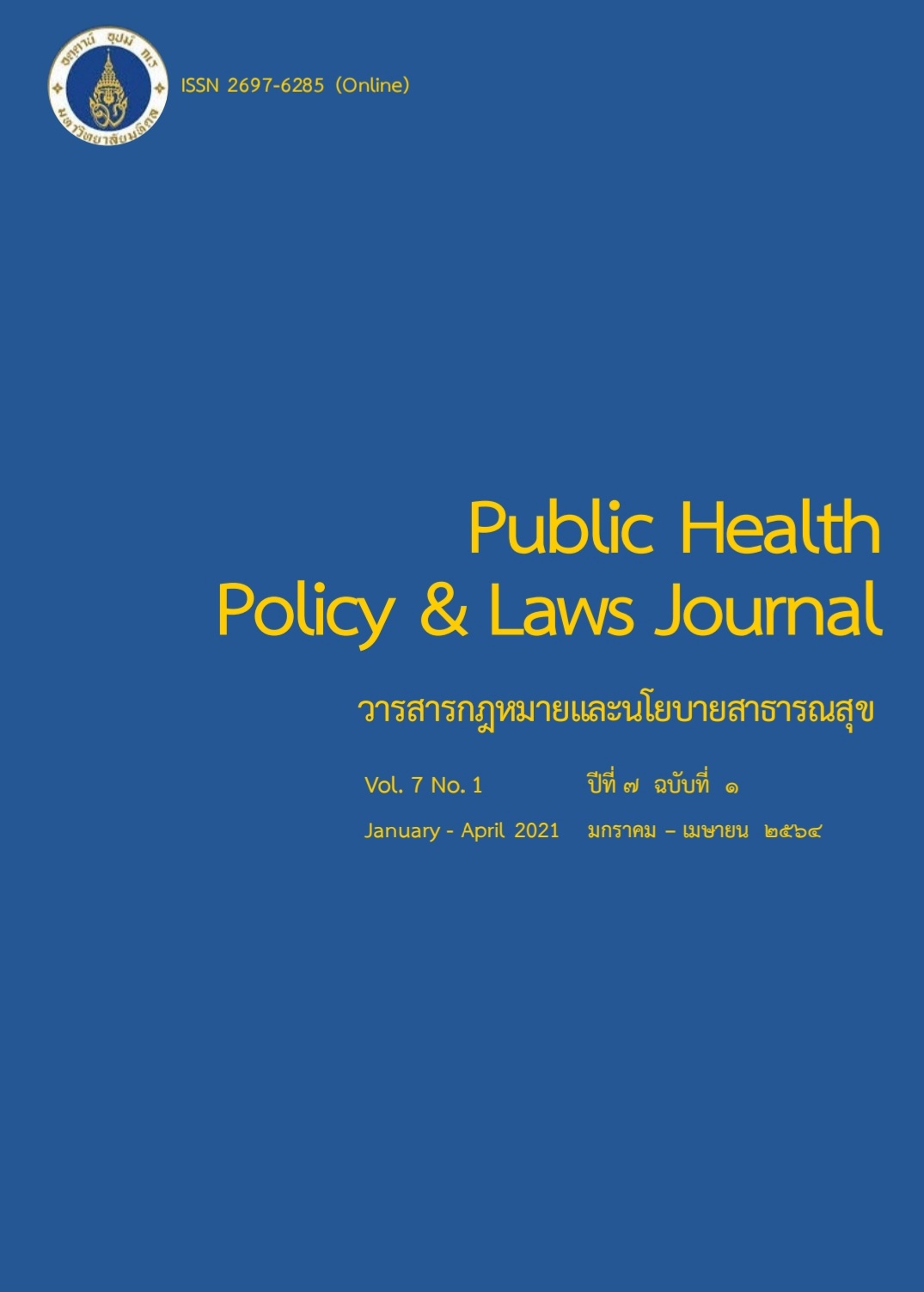Traditional Chinese Medicine Law with Thai Health System
Keywords:
Traditional Chinese Medicine, Health System, Standard of Traditional Chinese Medicine PractitionerAbstract
Chinese medicine develops from therapeutic experience to survive Chinese illnesses that have accumulated for thousands of years. It plays a role in modern medicine and Thai medicine in healthcare, brought by Chinese people who migrated to Thailand during Sukhothai era. Chinese medicine sees the human body as a whole, makimg up of basic essential substances. (Jing 精 Essence), power (Qi 气 Qi), and spirit (Shen 神 Spirit), relying on a combination of 4 methods of examination: ""Wang 望" "Wen 闻" "Wen 问" "qie". To find out what caused the disease, symptoms, and location of the disease, and the analysis of the mechanism of the disease. Basic principles of traditional Chinese medicine came from the philosophy and ethics of Taoism and Confucius, focusing on holistic health. The standard stipulated in the Chinese medicine practice is the practice of Chinese doctors in various medical facilities in Thailand. There is a health service in the same direction, with quality and professional development standards to protect the benefits of patients. The medical system of treatment is a combination of modern medicine and alternative medicine for greater integration around the treatment. In traditional Chinese medicine. It is necessary to respect and maintain its uniqueness, a holistic concept. Four combined examinations based on the classification of the disease. If you violate the concept and principles, it can't be called Traditional Chinese medicine because its uniqueness is different from the science that makes Traditional Chinese medicine a long-lasting success.
References
กรมสนับสนุนบริการสุขภาพ.(2558).มาตรฐานการประกอบโรคศิลปะสาขาการแพทย์แผนจีน.Professional Standards of Practitioner for Traditional Chinese Medicine. สํานักสถานพยาบาลและการประกอบโรคศิลปะ, กรมสนับสนุนบริการสุขภาพ.โรงพิมพ์องค์การสงเคราะห์ทหารผ่านศึก.
พัชนา (เฮ้งบริบูรณ์พงศ์) ใจดี, กุหลาบ รัตนสัจธรรม, ศิริพร จันทร์ฉาย.(2556).“การแพทย์แผนจีน” กับการสาธารณสุขไทย.วารสารสาธารณสุขมหาวิทยาลัยบูรพา.8(2):112-118.
ราชกิจจานุเบกษา.(2542).พระราชบัญญัติการประกอบโรคศิลปะ พ.ศ. 2542.เล่มที่ 116 ตอนที่ 39 ก. 18 พฤษภาคม 2542.หน้า 28-48. แหล่งที่มา:
http://www.ratchakitcha.soc.go.th/DATA/PDF/2542/A/039/28.PDF
ราชกิจจานุเบกษา.(2556).พระราชบัญญัติการประกอบโรคศิลปะ พ.ศ.2556 (ฉบับที่ 4). เล่ม 130 ตอนที่ 13 ก. 6 กุมภาพันธ์ 2556.หน้า 1-12.
ราชกิจจานุเบกษา .(2555). ระเบียบกระทรวงสาธารณสุข ว่าด้วยบุคคลซึ่งปฏิบัติงานในสถานพยาบาลตากฎหมายว่าด้วยสถานพยาบาลกระทำการประกอบโรคศิลปะสาขาการแพทย์แผนจีนในความควบคุมของผู้ประกอบโรคศิลปะสาขาการแพทย์แผนจีน พ.ศ.2555.เล่มที่ 129 ตอนพิเศษ 79 ง.11พฤษภาคม 2555.แหล่งที่มา: https://hss.moph.go.th/fileupload_doc_slider/2016-11-15--130.pdf
ราชกิจจานุเบกษา. (2559). ระเบียบกระทรวงสาธารณสุขว่าด้วยหลักจรรยาบรรณแห่งวิชาชีพของผู้ประกอบโรคศิลปะ พ.ศ.2559.เล่มที่ 133 ตอนพิเศษ 56 ง.19 กุมภาพันธ์ 2559.1-5
เย็นจิตร เตชะดำรงสิน (2556). หนึ่งทศวรรษการแพทย์แผนจีนในประเทศไทย. ใน รายงานการสาธารณสุขไทยด้านการแพทย์แผนไทย การแพทย์พื้นบ้าน และการแพทย์ทางเลือก 2554-2556. สำนักข้อมูลและประเมินผล กรมพัฒนาการแพทย์แผนไทยและการแพทย์แผนทางเลือกกระทรวงสาธารณสุข.249-253
สำนักการแพทย์ทางเลือก.(2556).การแพทย์แผนจีน (Traditional Chinese Medicine).วารสารสำนักการแพทย์ทางเลือก.6(1).1-10.
สํานักงานคณะกรรมการกฤษฎีกา.(2510).พระราชบัญญัติยา พ.ศ.2510.แหล่งที่มา: http://203.155.220.230/bmainfo/law/011/medicine2510.pdf
สำนักงานคณะกรรมการกฤษฎีกา.(2550).พระราชบัญญัติสุขภาพแห่งชาติพ.ศ. 2550. แหล่งที่มา: http://web.krisdika.go.th/data/law/law2/%CA71/%CA71-20-9999-update.htm
Downloads
Published
How to Cite
Issue
Section
License
Disclaimer and Copyright Notice
The content and information presented in articles published in the Journal of Law and Public Health Policy represent the opinions and sole responsibility of the respective authors. The editorial board does not necessarily agree with or assume any responsibility for the views expressed.
All articles, data, content, images, and other materials published in the Journal of Law and Public Health Policy are the intellectual property of the journal. Any individual or organization wishing to reproduce, distribute, or otherwise use the entirety or any part of such materials must provide proper citation.





